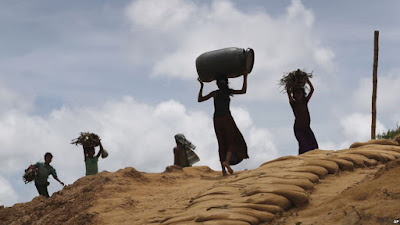YANGON — The Bangladeshi government has registered thousands of orphans in Rohingya refugee camps as officials and aid groups attempt to figure out a plan to deal with large numbers of unaccompanied minors.
Nearly 600,000 stateless Rohingya Muslims have left Myanmar since attacks by the Arakan Rohingya Salvation Army on August 25, sparking a military response that rights groups and the United Nations have described as ethnic cleansing.
A majority of those who have fled are children, and many may have lost their parents in Myanmar or along the way. Children in UNICEF's child-friendly centers have drawn gruesome pictures of military raids and violent attacks on villagers, though Myanmar vigorously denies targeting civilians.
WATCH: UNHCR Drone Footage of Rohingya Refugees
Difficult task
Pritam Kumar Chowdhury, the deputy director of the Social Welfare Department in Cox’s Bazar district, said there may be more than 15,000 orphans, though he says verifying individual claims is difficult with scant additional information.
“In Bangladesh, when we identify any orphan, our officials visit their house to confirm it. But here it is not possible to go to Myanmar to verify the claims. So whatever they are saying we are collecting that information,” he told VOA, adding that the government is also talking to neighbors and people whom the children may have traveled with from Myanmar.
“But there is no evidence, rather we are depending on the verbal statement. We are maintaining our strategy to complete the formalities. We are not claiming it is 100 percent correct but it is not all a wrong list.”
 |
| Rohingya Muslim children, who crossed over from Myanmar into Bangladesh, stretch out their arms out to collect chocolates and milk distributed by Bangladeshi men at Taiy Khali refugee camp, Bangladesh, Sept. 21, 2017. |
Jean-Jacques Simon, a spokesperson for UNICEF, said in an email that out of the 14,740 children registered as "orphans" with the government, half of the cases have been reviewed and entered into the Ministry of Social Welfare database.
There were only 15 known cases of children actually living completely alone in the camps. UNICEF says it is in contact with the government at the local level "to know where these 15 children are right now and to ensure their protection."
Chaotic situation
The dusty roads of the camps and makeshift settlements in southern Bangladesh are teeming with children, some attended by adults and others not, and the chaotic situation makes them vulnerable to abuse and other risks.
“We really need to have a space for the children,” said Dr. Erum Mariam, the director of the BRAC Institute of Educational Development.
BRAC, an NGO based in Bangladesh, has helped organize clothing donations for children, build child-friendly spaces, and provide on-site counsellors.
 |
| Rohingya children walk to their tents after fetching drinking water at a makeshift camp near Kutupalong refugee camp in Cox's Bazar, Bangladesh, Oct. 3, 2017. |
“We are really working on many different levels now,” she said.
The government has also floated the idea of building orphanages, and discussed the idea with aid groups this week, Mariam said.
If the idea does move forward, it’s important to have the capacity to make it work, she added.
“There has to be so much engagement with the children, and understanding, understanding the trauma,” she said.
Pritam, with the Social Welfare Department, said more concrete options will be considered once officials have a clearer idea of the scope of the problem.
“Their fate will be decided by the government. But until then, we are concentrating on registration. Whatever the decision will be will come afterwards,” he said.









































